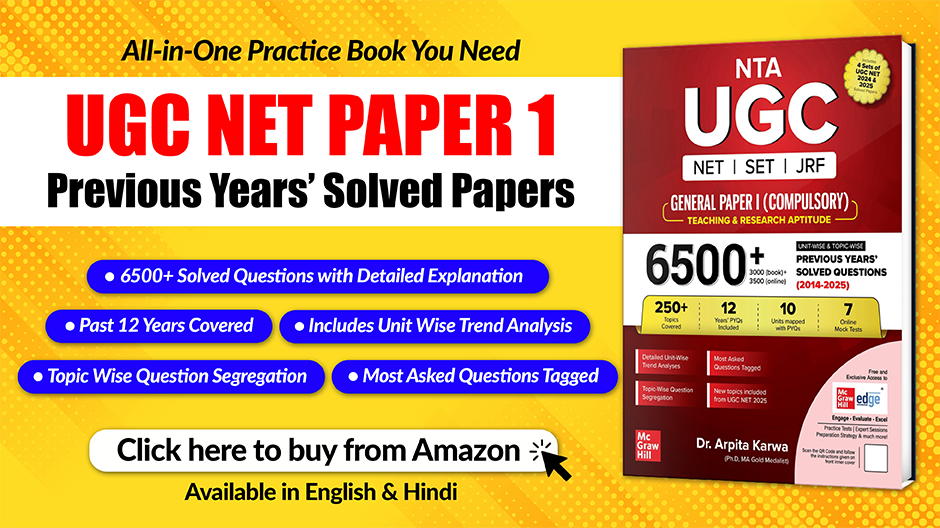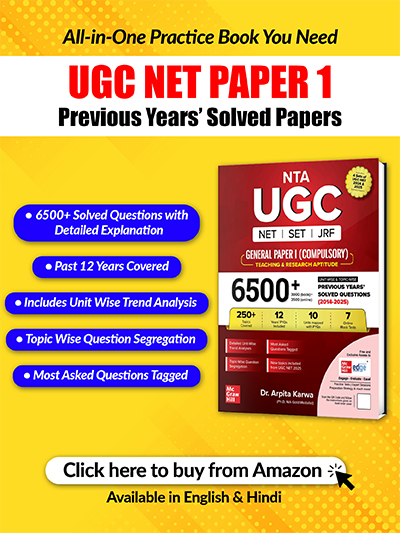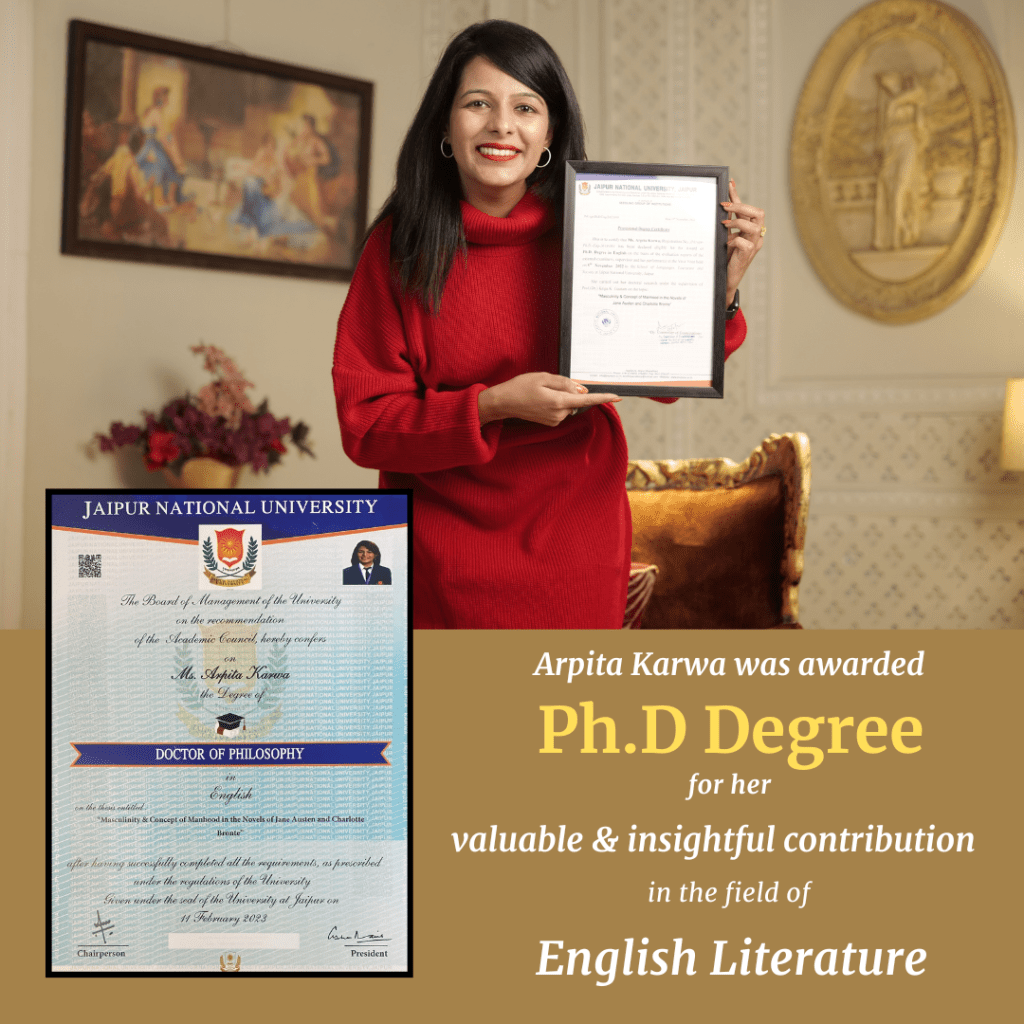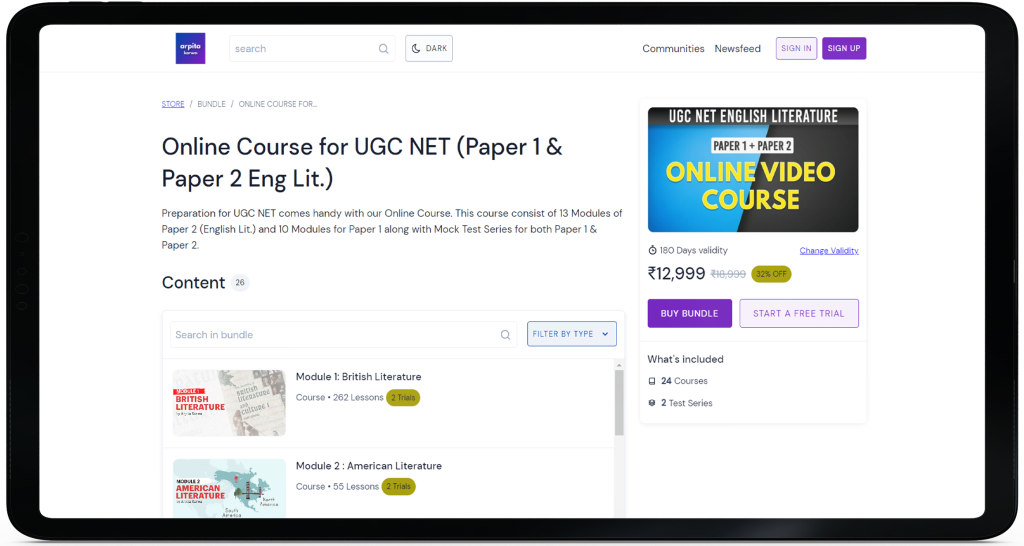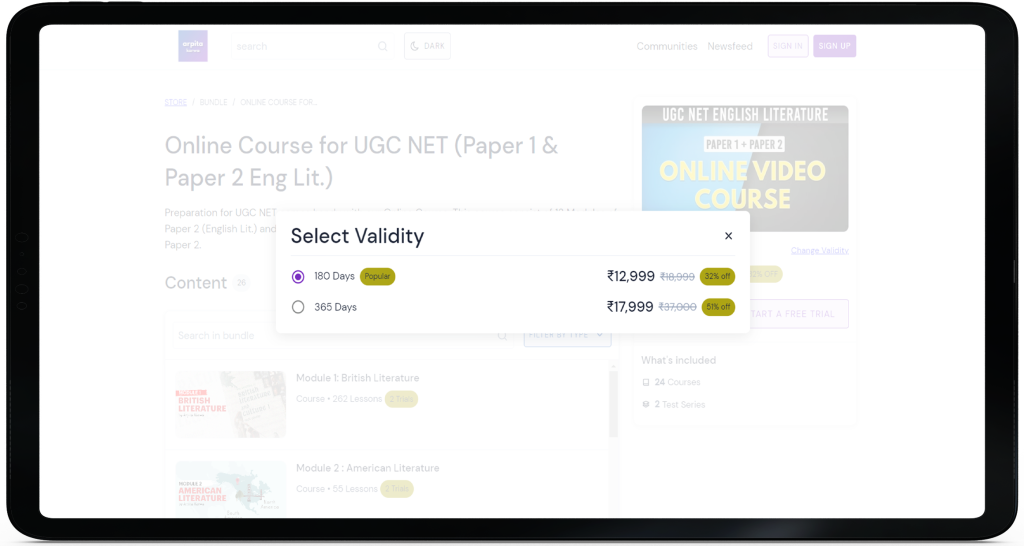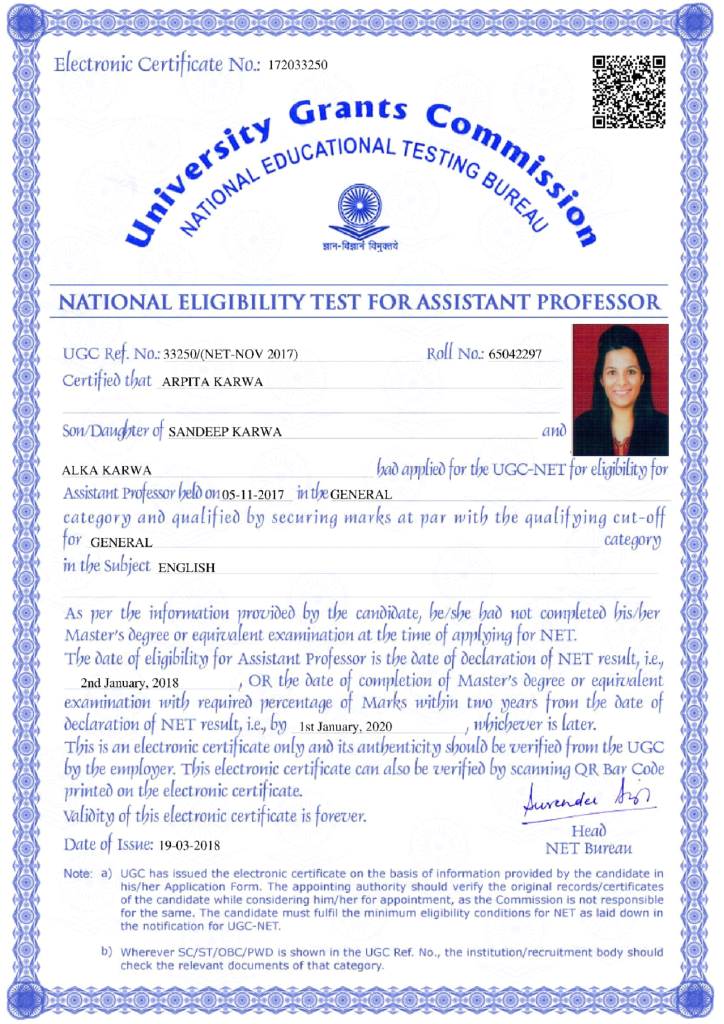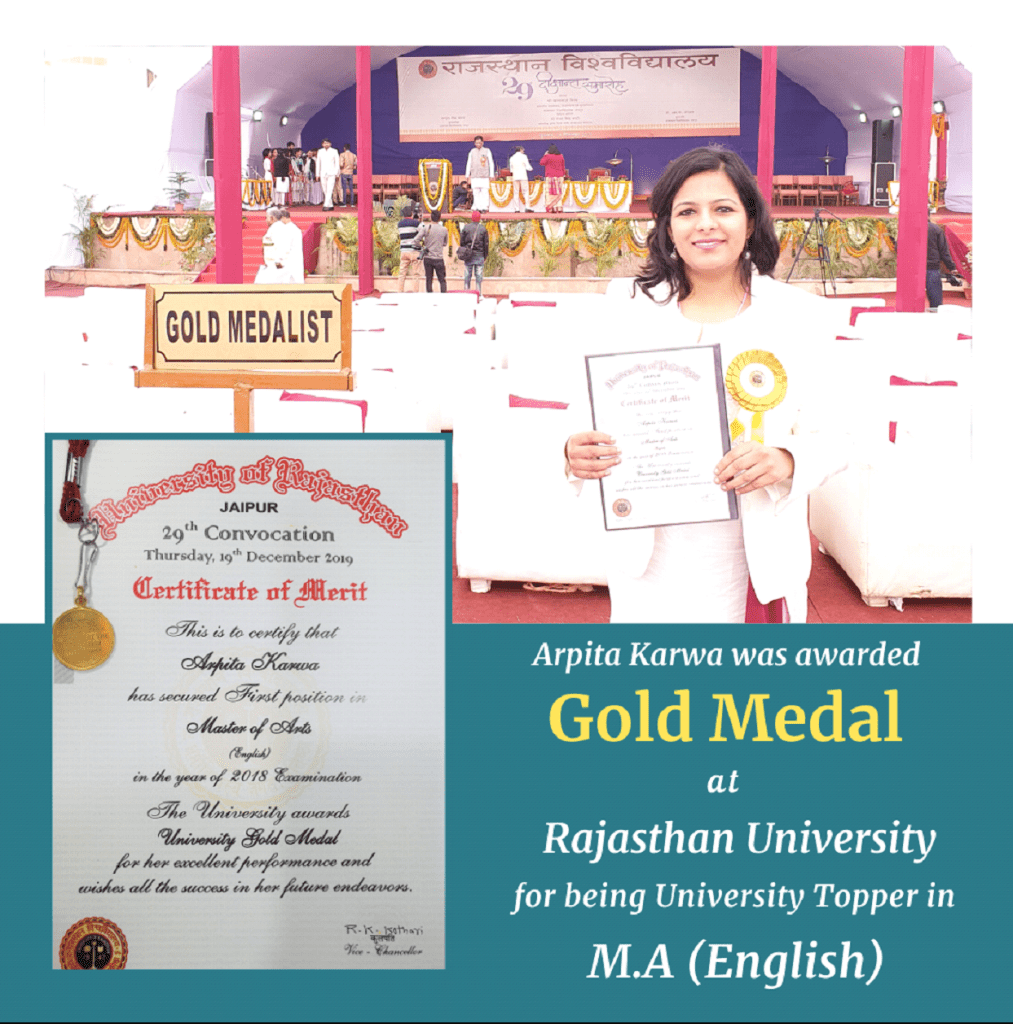UGC NET Paper 1 October 2020 (Conducted on 9th October 2020 : Morning Shift)
October 18, 2022 2025-08-18 13:56UGC NET Paper 1 October 2020 (Conducted on 9th October 2020 : Morning Shift)
October 2020: Paper 1 (Conducted on 9th Oct 2020 : Morning Shift)
Q.1-5)
Q.1) The difference between the number of candidates who appeared and qualified in the test from Zone-M in the given period was the second lowest in the year :
[1] 2014
[2] 2016
[3] 2017
[4] 2019
Correct Answer: 2
Explanation:
For Zone M:
2014: Appeared (A) = 420, Qualified (Q) = 240, Difference = 420 – 240 = 180
2015: Appeared (A) = 740, Qualified (Q) = 330, Difference = 740 – 330 = 410
2016: Appeared (A) = 830, Qualified (Q) = 560, Difference = 830 – 560 = 270
2017: Appeared (A) = 930, Qualified (Q) = 640, Difference = 930 – 640 = 290
2018: Appeared (A) = 1140, Qualified (Q) = 520, Difference = 1140 – 520 = 620
2019: Appeared (A) = 1420, Qualified (Q) = 1180, Difference = 1420 – 1180 = 240
Hence, The lowest difference is in 2014 (180), and the second lowest is in 2016 (270).
Q.2) The number of candidates who appeared in the test from Zone — K in the year 2017 was approximately what percentage of the number of candidates who qualified the test from the Zone — L in the year 2019:
[1] 88%
[2] 83%
[3] 73%
[4] 68%
Correct Answer: 3
Q.3) What was the average number of candidates who appeared in the test from Zone — N over all the years together?
[1] 810
[2] 815
[3] 825
[4] 805
Correct Answer: 4
Q.4) The ratio of the number of candidates who appeared in the test from the Zone — J in the year 2014 to the number of candidates who qualified the test from the Zone — M in the year 2016 was :
[1] 4:7
[2] 4:9
[3] 9:4
[4] 8:13
Correct Answer: 1
Q.5) The total number of candidates who qualified the test in the year 2018 and 2019 together was the second highest in the zone :
[1] J
[2] N
[3] K
[4] L
Correct Answer: 2
Q.6) An open classroom environment marked by sharing and caring by teachers and students in their interchanges will be most helpful for which level of teaching?
[1] Memory level
[2] Understanding level
[3] Reflective level
[4] Autonomous development level
Correct Answer: 3
Q.7) Which will be the correct hierarchical sequencing for the following types of learning?
(A) Discrimination learning
(B) Sign learning
(C) Concept learning
(D) Problem solving learning
(E) Rule learning
[1] BACED
[2] ABEDC
[3] DCBAE
[4] CDEAB
Correct Answer: 1
Q.8) Which of the following research forms, aims primarily at putting to use the theoretical advances with an eye on exploring the potential for generalizability?
[1] Fundamental research
[2] Evaluative research
[3] Action research
[4] Applied research
Correct Answer: 4
Q.9) Which of the following intellectual characteristics in a teacher need nurturing in order to accomplish subjective well-being leading to effectiveness in motivating and inspiring students of college level education?
[1] Cognitive intelligence related
[2] Emotional intelligence related
[3] Social intelligence related
[4] Spiritual intelligence related
Correct Answer: 2
Q.10) Statement I: Instructional technology is a network of techniques pressed into service for realizing instructional objectives.
Statement I : Computer-aided instruction can replace the teacher if the goal of education is personality development.
[1] Both Statement I and Statement II are true
[2] Both Statement I and Statement II are false
[3] Statement I is correct but Statement II is false
[4] Statement I is incorrect but Statement II is true
Correct Answer: 3
Q.11) In a research project using ‘triangulation’ approach which of the following can form part of the investigation on studying “parental participation, attitude and problems”?
(A) Interview
(B) Observation
(C) Tests
(D) Sociometry
(E) Focused group discussion
[1] ABC
[2] CBD
[3] CDE
[4] ADE
Correct Answer: 4
Q.12) In which method of research the independent variable is manipulated to observe and measure its effect on dependent variable?
[1] Ex-post facto method
[2] Experimental method
[3] Case study method
[4] Historical method
Correct Answer: 2
Q.13) In which of the following there is considerable scope for violation of research ethics?
(A) Problem formulation
(B) Data interpretation
(C) Hypothesis making
(D) Reporting of research results
(E) Using research tools prepared by others
[1] ABC
[2] BCD
[3] BDE
[4] CDE
Correct Answer: 3
Q.14) Statement I: A research hypothesis is a conjectural statement postulating the relationship among variables with a view to advance solution to the problem of study.
Statement II: The Non-probability sampling procedures provide the best estimate for the population parameter.
[1] Both Statement I and Statement II are true
[2] Both Statement I and Statement II are false
[3] Statement I is correct but Statement II is false
[4] Statement I is incorrect but Statement II is true
Correct Answer: 3
Q.15) Which of the characteristics in classroom teaching behavior as given below will be classified as a part of formative assessment?
(A) The teacher asks question to elicit classification from students.
(B) The teacher specifies the level of mastery attained by students.
(C) The teacher prompts and probes the students while making presentation.
(D) The teacher pauses for a few seconds. looks at students and asks questions.
(E) The teacher indicates performance criteria and given judgemental values.
[1] ABC
[2] ACD
[3] BCD
[4] CDE
Correct Answer: 2
Q.16) Poor listening by the audience leads to-
[1] Appreciating the speaker
[2] Wild imaginations
[3] Inaccurate inferences
[4] Disrespecting the speaker
Correct Answer: 3
Q.17) Match the column:
A. Aristotle
B. Shannon and Weaver
C. Wilbur Schramm
D. David Berlo
I. SMCR- sender, message, channel, receiver-model
II. circular communication
III. Speaker- centered communication
IV. Top-down, linear communication
[1] A-I B-II C-III D-IV
[2] A-II B-III C-IV D-I
[3] A-III B-IV C-II D-I
[4] A-IV B-I C-III D-II
Correct Answer: 3
Q.18) Identify the chronological sequence of the following countries opting for educational broadcasting channels
(A) Great Britain
(B) The United States
(C) Australia
(D) India
(E) Canada
[1] BAECD
[2] CDEAB
[3] DEBCA
[4] ABDEC
Correct Answer: 1
Q.19) Statement I: Free and unlimited use of non-verbal cues enhance the communicative aspects of classroom teaching.
Statement II: A pleasant persona of the teacher enlivens the classroom eco-system.
[1] Both Statement I and Statement II are true
[2] Both Statement I and Statement II are false
[3] Statement I is correct but Statement II is false
[4] Statement I is incorrect but Statement II is true
Correct Answer: 4
Q.20) The consequences of effective classroom communication are-
(A) Enhanced expectations of teacher from students
(B) Learning as satisfying pursuit
(C) Increased promotional prospects for teachers
(D) Enabling students to achieve goals
(E) Positive learning outcomes
[1] ABC
[2] BCD
[3] CDE
[4] BDE
Correct Answer: 4
Q.21) What part of 1/12 is 3/8 ?
[1] 3/7
[2] 4/7
[3] 1/12
[4] 9/2
Correct Answer: 4
Q.22) Rajiv. Sanjiv and Vijay join a running race. The distance is 1500 meters. Rajiv beats Sanjiv by 30 meters and Vijay by 100 meters. By how much could Sanjiv beat Vijay over the full distance if they both ran as before?
[1] 72.3 meters
[2] 71.5 meters
[3] 71.4 meters
[4] 70.2 meters
Correct Answer: 3
Q.23) Statement I: If you know the length of two sides of a right angled triangle then the length of the third side can not be found.
Statement II : The internal angles of a triangle add upto 180°.
[1] Both Statement I and Statement II are true
[2] Both Statement I and Statement II are false
[3] Statement I is correct but Statement II is false
[4] Statement I is incorrect but Statement II is true
Correct Answer: 4
Q.24) The given equation becomes correct after interchanging two signs. One of the four alternatives under it specifies the interchange of signs in the equation which when made will make the equation correct.
Find the correct alternative?
9+5÷4×3-6 = 12
[1] + and –
[2] ÷ and –
[3] + and ×
[4] ÷ and ×
Correct Answer: 2
Q.25) Find the Odd one out in following sequence :
1,5, 14, 80, 50, 55, 91
[1] 14
[2] 30
[3] 50
[4] 55
Correct Answer: 3
Q.26) “Fat Krishnadatta eats either during day or night, Fat Krishnadatta does not eat during day, therefore fat Krishnadatta eats during night”. The above is an example of which type of inference?
[1] Comparison (upmana)
[2] Verbal testimony (Shabda)
[3] Negation (Anupalabdhi)
[4] TImplication (Arthapatti)
Correct Answer: 4
Q.27) A and B play Football, Cricket and Hockey. B and C play Hockey and Badminton. C and D play Badminton and Tennis. D and A play Football, Cricket and Tennis. Find out the correct answer among the following :
(A) C does not play Cricket
(B) B and D both play Tennis
(C) A plays football, Cricket and Badminton
(D) A, B and D play Football and Cricket
(B) Except B all play Tennis
[1] ABE
[2] ADE
[3] ABC
[4] CDE
Correct Answer: 2
Q.28) What will come in place of the question mark (?) in the following series?
U,O,I,?,A
[1] M
[2] G
[3] B
[4] E
Correct Answer: 4
Q.29) If the day before yesterday was Friday, what will be the third day after the day after tomorrow?
[1] Friday
[2] Saturday
[3] Thursday
[4] Wednesday
Correct Answer: 1
Q.30) Match the column:
A. lizard : reptile
B. tennis : court
C. bull : cow
D. botany : plant
I. skating : rink
II. haematology : blood
III. eagle : bird
IV. wizard : witch
[1] A-I B-III C-IV D-II
[2] A-II B-IV C-I D-III
[3] A-III B-I C-IV D-II
[4] A-IV B-III C-II D-I
Correct Answer: 3
Q.31) In computers, a DVD-ROM is :
[1] an optical storage media and it can be written many times.
[2] a magnetic storage media and it can be written only once.
[3] anoptical storage media and it can be written only once.
[4] amagnetic storage media and it can be written many times.
Correct Answer: 3
Q.32) With regard to computer memory. which of the following statement(s) is/are TRUE?
(A) Cache memory is ‘volatile’ memory.
(B) Magnetic memory is ‘volatile’ memory.
(C) Flash memory is volatile memory.
(D) RAM is ‘volatile’’ memory.
[1] AB
[2] D
[3] AD
[4] CD
Correct Answer: 3
Q.33) The Recycle Bin is an area in Windows OS that contains files deleted from the :
(A) hard drive
(B) Pendrive
(C) CDROM
[1] A
[2] AB
[3] BC
[4] AC
Correct Answer: 1
Q.34) Identify the correct order of the following computer memories on the basis of increasing memory access time (from low to high).
(A) Registers
(B) Main Memory
(C) Secondary Memory
(D) Cache Memory
[1] ACDB
[2] ADBC
[3] CBDA
[4] BDAC
Correct Answer: 2
Q.35) Statement I: The minimum number of bits required to store any 3-digit decimal number is 10.
Statement II: The data in a digital computer is stored in terms of bits/ bytes where one PetaByte is equal to 2^50 bits.
[1] Both Statement I and Statement II are true
[2] Both Statement I and Statement II are false
[3] Statement I is correct but Statement II is false
[4] Statement I is incorrect but Statement II is true
Correct Answer: 3
Q.36) India has huge Thorium reserve, a potential source of nuclear energy. This thorium reserve is mainly confined in the
[1] rocks of Chhota Nagpur plateau
[2] muds of Sunderban delta
[3] coastal sands of Kerala sea
[4] sands of Thar desert
Correct Answer: 3
Q.37) Identify the objectives specific to Sustainable Development Goals among the following :
(A) Responsible consumption and production
(B) Life on land
(C) Improving maternal health
(D) Ensuring environmental sustainability
(E) Reduced inequality
[1] ABE
[2] ACDE
[3] BCDE
[4] ABCDE
Correct Answer: 1
Q.38) Assertion (A): Emissions from diesel vehicles are relatively less harmful to human health in comparison to petrol vehicles.
Reason (R): Emissions of hydrocarbons and carbon monoxide are inherently very low from diesel vehicles.
[1] Both (A) and (R) are correct and (R) is the correct explanation of (A)
[2] Both (A) and (R) are correct but (R) is NOT the correct explanation of (A)
[3] (A) is correct but (R) is not correct
[4] (A) is not correct but (R) is correct
Correct Answer: 4
Q.39) Assertion (A): Solar ponds store solar energy in the form of heat.
Reason (R) : Solar ponds contain water with definite gradient of salt concentration.
[1] Both (A) and (R) are correct and (R) is the correct explanation of (A)
[2] Both (A) and (R) are correct but (R) is NOT the correct explanation of (A)
[3] (A) is correct but (R) is not correct
[4] (A) is not correct but (R) is correct
Correct Answer: 1
Q.40) Which of the following sectors contributed least to the global carbon dioxide emissions in the year 2014 as per IPCC report?
[1] Transportation
[2] Agriculture and forest land use
[3] Industry
[4] Utility (Electricity and Heat Production)
Correct Answer: 1
Q.41) MHRD, Government of India, initiative e-ShodhSindhu provides students and researchers access to-
[1] Indian Ph.D thesis in electronic form
[2] e-journals
[3] Plagiarism software
[4] Open source software for training in analytical techniques
Correct Answer: 2
Q.42) Which of the following ancient educational institutions was situated at the banks of river Ganga?
[1] Nalanda University
[2] Pushpagiri University
[3] Vikramshila University
[4] Takshashila University
Correct Answer: 3
Q.43) As per National Skills Qualifications Framework (NSQF). undergraduate B.Voc. degree programme requires completion of how many credits of Course Work?
[1] 60 Credits
[2] 80 Credits
[3] 120 Credits
[4] 180 Credits
Correct Answer: 4
Q.44) ‘MHRD’ is the full form of ‘ARIA’, a scheme of the Government of India.
[1] Atal Ranking of Institutions on Innovation Achievements
[2] Atal Research Initiative on Innovation and Academics
[3] Academic Ranking of Indian Institutions Achievements
[4] Atal Ranking of Indian Institutions Achievements
Correct Answer: 1
Q.45-49) Read RC Passage to Answer:
Initially, most children want to do well in school. But the student who has experienced consistent failure in the classroom tends to lower his own expectations concerning school success. He may direct his energy outside the classroom to athletics or youth gangs or to other areas where he can experience the satisfaction of success. The student who has been negatively evaluated in the classroom rationalizes that school is not important to him because he believes it is impossible for him to succeed there.
If a student is to continue to expect to do well in school, he needs to receive some positive evaluations for his academic performance. If an individual is to develop a positive concept of himself as a student, he needs to perform competently and to receive evaluations that he interprets to be positive within his own frame of reference. When the student is perceived as a less competent learner. forces are set in motion that reduce the chances that his potential will be developed to its fullest extent in school. The other students and his teachers may come to view him as having less potential than he really has. The academic goals he sets for himself and those that are set for him by his well intentioned teachers may not sufficiently challenge his true abilities. A student may divert his own personal resources to non-academic areas because he believes that success in academic subjects is not open to him. If he does not apply his maximum efforts to learning school subjects. he may fail to acquire some of the skills and knowledge he needs as a basis for further learning.
Q.45) A student. who is consistently poor performer in the class room. will
[1] Strive hard to achieve his goals later.
[2] Lower the image of the school in his eyes.
[3] Aggressively complete with classmates outside the school
[4] Not expect much success in the school.
Correct Answer: 4
Q.46) What s the likely impact of negative evaluation of the student in the classroom?
[1] He will be jealous of his classmates.
[2] He will divert his attention to other fields for success.
[3] He will perform well in athletics.
[4] He gets into a state of depression.
Correct Answer: 2
Q.47) Positive evaluation of a student’s academic performance will help him to
[1] perform well in future also
[2] take up athletics
[3] make friends
[4] be considered as a role model by other students
Correct Answer: 1
Q.48) When a student is considered as less than competent what can be the outcome?
(A) He may feel that his potential is not properly assessed.
(B) He may think that others do not want him to succeed in academics.
(C) Others in the school may rate his potential less than what he actually possesses.
(D) He may divert his personal resources to non-academic areas.
[1] AB
[2] BC
[3] CD
[4] AD
Correct Answer: 3
Q.49) The gist of the passage is that
[1] A less competent student should seek his future in areas other than academics.
[2] He should put maximum efforts to have a successful academic performance.
[3] Teachers should motivate him to use his personal resources properly.
[4] He should evaluate his own skills and knowledge as against teacher’s expectations.
Correct Answer: 2


